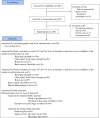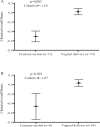Association of objectively measured physical fitness during pregnancy with maternal and neonatal outcomes. The GESTAFIT Project
- PMID: 32069319
- PMCID: PMC7028270
- DOI: 10.1371/journal.pone.0229079
Association of objectively measured physical fitness during pregnancy with maternal and neonatal outcomes. The GESTAFIT Project
Erratum in
-
Correction: Association of objectively measured physical fitness during pregnancy with maternal and neonatal outcomes. The GESTAFIT Project.PLoS One. 2020 Apr 1;15(4):e0231230. doi: 10.1371/journal.pone.0231230. eCollection 2020. PLoS One. 2020. PMID: 32236140 Free PMC article.
Abstract
Aim: To analyse i) the association of physical fitness during early second trimester and late pregnancy with maternal and neonatal outcomes; and ii) to investigate whether physical fitness is associated with the type of birth (vaginal or caesarean section).
Methods: Pregnant women from the GESTAFIT Project (n = 159) participated in this longitudinal study. Maternal physical fitness including upper- and lower-body strength, cardiorespiratory fitness (CRF) and flexibility were measured through objective physical fitness tests at the 16th and 34th gestational weeks. Maternal and neonatal outcomes were collected from obstetric medical records. Umbilical arterial and venous blood gas pH and partial pressure of carbon dioxide (PCO2) and oxygen (PO2), were assessed.
Results: At the 16th week, greater upper-body muscle strength was associated with greater neonatal birth weight (r = 0.191, p<0.05). Maternal flexibility was associated with a more alkaline arterial pH (r = 0.220, p<0.05), higher arterial PO2 (r = 0.237, p<0.05) and lower arterial PCO2 (r = -0.331, p<0.01) in umbilical cord blood. Maternal CRF at the 16th gestational week was related to higher arterial umbilical cord PO2 (r = 0.267, p<0.05). The women who had caesarean sections had lower CRF (p<0.001) at the 16th gestational week and worse clustered overall physical fitness, both at the 16th (-0.227, p = 0.003, confidence interval (CI): -0.376, -0.078) and 34th gestational week (-0.223; p = 0.018; CI: -0.432, -0.015) compared with the women who had vaginal births.
Conclusion: Increasing physical fitness during pregnancy may promote better neonatal outcomes and is associated with a decrease in the risk of caesarean section. This trial was registered at ClinicalTrials.gov (NCT02582567) on October 20, 2015.
Conflict of interest statement
The authors have declared that no competing interests exist.
Figures
Similar articles
-
Association of Self-Reported Physical Fitness during Late Pregnancy with Birth Outcomes and Oxytocin Administration during Labour-The GESTAFIT Project.Int J Environ Res Public Health. 2021 Aug 3;18(15):8201. doi: 10.3390/ijerph18158201. Int J Environ Res Public Health. 2021. PMID: 34360494 Free PMC article. Clinical Trial.
-
Association of sedentary time and physical activity during pregnancy with maternal and neonatal birth outcomes. The GESTAFIT Project.Scand J Med Sci Sports. 2019 Mar;29(3):407-414. doi: 10.1111/sms.13337. Epub 2018 Dec 17. Scand J Med Sci Sports. 2019. PMID: 30450596
-
Physical fitness and maternal body composition indices during pregnancy and postpartum: the GESTAFIT project.Eur J Sport Sci. 2023 Aug;23(8):1720-1730. doi: 10.1080/17461391.2022.2115405. Epub 2022 Sep 12. Eur J Sport Sci. 2023. PMID: 35986555
-
The intrapartum and perinatal risks of sleep-disordered breathing in pregnancy: a systematic review and metaanalysis.Am J Obstet Gynecol. 2018 Aug;219(2):147-161.e1. doi: 10.1016/j.ajog.2018.02.004. Epub 2018 Feb 15. Am J Obstet Gynecol. 2018. PMID: 29454869
-
Assessment of physical fitness during pregnancy: validity and reliability of fitness tests, and relationship with maternal and neonatal health - a systematic review.BMJ Open Sport Exerc Med. 2022 Sep 23;8(3):e001318. doi: 10.1136/bmjsem-2022-001318. eCollection 2022. BMJ Open Sport Exerc Med. 2022. PMID: 36172399 Free PMC article.
Cited by
-
Physical activity trajectory during pregnancy and associations with maternal fatigue using a growth mixture modeling approach.Sci Rep. 2024 Jan 10;14(1):1020. doi: 10.1038/s41598-024-51648-w. Sci Rep. 2024. PMID: 38200232 Free PMC article.
-
Association of Self-Reported Physical Fitness during Late Pregnancy with Birth Outcomes and Oxytocin Administration during Labour-The GESTAFIT Project.Int J Environ Res Public Health. 2021 Aug 3;18(15):8201. doi: 10.3390/ijerph18158201. Int J Environ Res Public Health. 2021. PMID: 34360494 Free PMC article. Clinical Trial.
-
Association between Flexibility, Measured with the Back-Scratch Test, and the Odds of Oxytocin Administration during Labour and Caesarean Section.J Clin Med. 2024 Sep 4;13(17):5245. doi: 10.3390/jcm13175245. J Clin Med. 2024. PMID: 39274458 Free PMC article.
-
Determination of hand grip strength and its correlates during pregnancy: a cross-sectional study.BMC Pregnancy Childbirth. 2021 Aug 4;21(1):540. doi: 10.1186/s12884-021-04003-0. BMC Pregnancy Childbirth. 2021. PMID: 34348682 Free PMC article.
-
Association of Self-Reported Physical Fitness with Pregnancy Related Symptoms the GESTAFIT Project.Int J Environ Res Public Health. 2021 Mar 24;18(7):3345. doi: 10.3390/ijerph18073345. Int J Environ Res Public Health. 2021. PMID: 33804923 Free PMC article.



